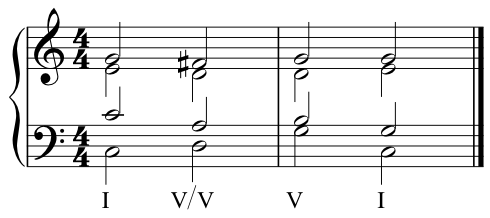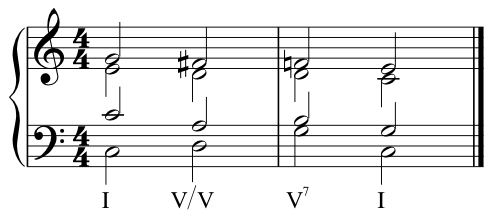Although this section is supposed to be about modulation, I’m going to start with a much more interesting and immediately useful idea called tonicization
.
This is probably the big payoff from music theory. I always used to wonder why, and more importantly how, a composer chose to sharpen or flatten a particular note in a harmony or a melody. That sharp or flat was obviously not a member of the key that the composition was in, nor did the piece obviously modulate (change key) at that point. The answer in almost all cases was a technique variously known as tonicisation
, borrowed chords
or what Piston calls the Secondary Dominant Principle
. Rather than waffle on any further, let’s take a slightly modified example from Piston to see how it works.

This short sequence is very much in the key of F major. Note that in the two boxes, the first chord stands in dominant relation to (a fourth below) the second, but in both cases the first chords are minor chords. If we make those chords major then they can act as true dominants to the following chord:

These chords are secondary dominants. They function as dominants of the following chord. In fact the Secondary Dominant Priciple states that any major or minor chord of a key may be preceeded by its dominant.
Notice that the names of the chords have changed. Instead of the major iii6 being written III6, which would be correct, it is written V/vi6 which gives a better idea of its function. The /
is read as “of”
, e.g. V6
of vi (the 6
suffix applies to the whole chord, so can be written last.)
Now these are not real modulations, since in both cases the piece continues in F major as if nothing had happened. In fact the chord IV in bar four has an F♮ and a B♭ that returns the key to F before the B♮ of V/V sets off in a new direction to the key of C. I have a rather colourful analogy that might help to visualise what is happening. It’s rather like a speed boat going very fast. it is both pointing in, and travelling in, one direction (key). If the captain turns the wheel, the boat will start to point in a new direction but will not actually start to change direction yet. If the wheel is righted so that it points in the old direction again, then the captain has just made the journey a little more exciting without actually changing course.
In many cases it is desirable to right the wheel very quickly after a tonicisation, by sounding the flattened leading note (third of the secondary dominant) as soon as possible. For example if the progression is V/V going to V followed by I:

then that final I sounds like IV/V. One common technique to rectify this is to replace chord V with chord V7, because the 7th of V is the flattened leading tone in the key of V:

Note that in this example the temporary leading tone, F♯ does not rise to the temporary tonic G but instead falls to the flattened seventh F♮ as part of a familiar chromatic sequence known as a Barber Shop
progression.
